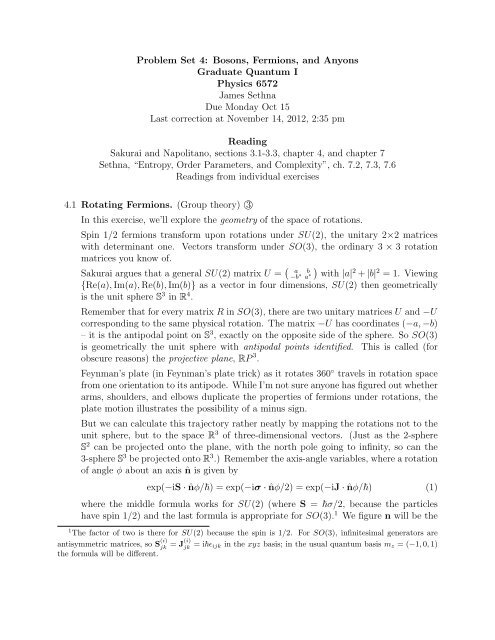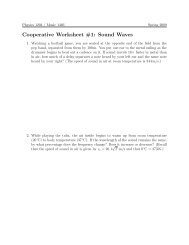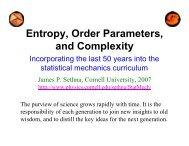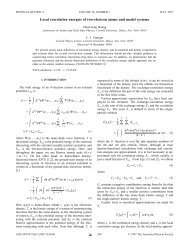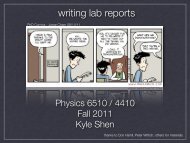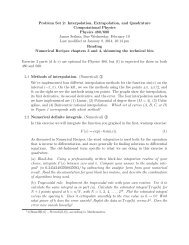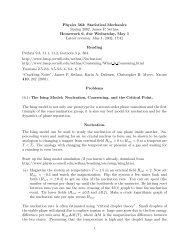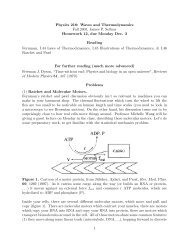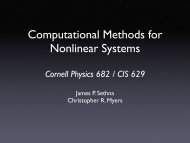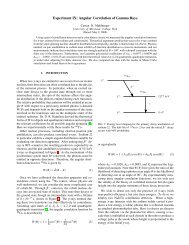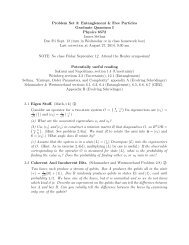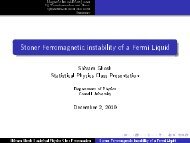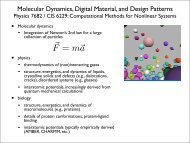4. Bosons, Fermions, and Anyons - Are you sure you want to look at ...
4. Bosons, Fermions, and Anyons - Are you sure you want to look at ...
4. Bosons, Fermions, and Anyons - Are you sure you want to look at ...
Create successful ePaper yourself
Turn your PDF publications into a flip-book with our unique Google optimized e-Paper software.
Problem Set 4: <strong>Bosons</strong>, <strong>Fermions</strong>, <strong>and</strong> <strong>Anyons</strong>Gradu<strong>at</strong>e Quantum IPhysics 6572James SethnaDue Monday Oct 15Last correction <strong>at</strong> November 14, 2012, 2:35 pmReadingSakurai <strong>and</strong> Napolitano, sections 3.1-3.3, chapter 4, <strong>and</strong> chapter 7Sethna, “Entropy, Order Parameters, <strong>and</strong> Complexity”, ch. 7.2, 7.3, 7.6Readings from individual exercises<strong>4.</strong>1 Rot<strong>at</strong>ing <strong>Fermions</strong>. (Group theory) ○3In this exercise, we’ll explore the geometry of the space of rot<strong>at</strong>ions.Spin 1/2 fermions transform upon rot<strong>at</strong>ions under SU(2), the unitary 2×2 m<strong>at</strong>riceswith determinant one. Vec<strong>to</strong>rs transform under SO(3), the ordinary 3 × 3 rot<strong>at</strong>ionm<strong>at</strong>rices <strong>you</strong> know of.Sakurai argues th<strong>at</strong> a general SU(2) m<strong>at</strong>rix U = ( )a b−b ∗ a with |a| 2 + |b| 2 = 1. Viewing∗{Re(a), Im(a), Re(b), Im(b)} as a vec<strong>to</strong>r in four dimensions, SU(2) then geometricallyis the unit sphere S 3 in R 4 .Remember th<strong>at</strong> for every m<strong>at</strong>rix R in SO(3), there are two unitary m<strong>at</strong>rices U <strong>and</strong> −Ucorresponding <strong>to</strong> the same physical rot<strong>at</strong>ion. The m<strong>at</strong>rix −U has coordin<strong>at</strong>es (−a, −b)– it is the antipodal point on S 3 , exactly on the opposite side of the sphere. So SO(3)is geometrically the unit sphere with antipodal points identified. This is called (forobscure reasons) the projective plane, RP 3 .Feynman’s pl<strong>at</strong>e (in Feynman’s pl<strong>at</strong>e trick) as it rot<strong>at</strong>es 360 ◦ travels in rot<strong>at</strong>ion spacefrom one orient<strong>at</strong>ion <strong>to</strong> its antipode. While I’m not <strong>sure</strong> anyone has figured out whetherarms, shoulders, <strong>and</strong> elbows duplic<strong>at</strong>e the properties of fermions under rot<strong>at</strong>ions, thepl<strong>at</strong>e motion illustr<strong>at</strong>es the possibility of a minus sign.But we can calcul<strong>at</strong>e this trajec<strong>to</strong>ry r<strong>at</strong>her ne<strong>at</strong>ly by mapping the rot<strong>at</strong>ions not <strong>to</strong> theunit sphere, but <strong>to</strong> the space R 3 of three-dimensional vec<strong>to</strong>rs. (Just as the 2-sphereS 2 can be projected on<strong>to</strong> the plane, with the north pole going <strong>to</strong> infinity, so can the3-sphere S 3 be projected on<strong>to</strong> R 3 .) Remember the axis-angle variables, where a rot<strong>at</strong>ionof angle φ about an axis ˆn is given byexp(−iS · ˆnφ/) = exp(−iσ · ˆnφ/2) = exp(−iJ · ˆnφ/) (1)where the middle formula works for SU(2) (where S = σ/2, because the particleshave spin 1/2) <strong>and</strong> the last formula is appropri<strong>at</strong>e for SO(3). 1 We figure n will be the1 The fac<strong>to</strong>r of two is there for SU(2) because the spin is 1/2. For SO(3), infinitesimal genera<strong>to</strong>rs areantisymmetric m<strong>at</strong>rices, so S (i)jk = J(i) jk = iɛ ijk in the xyz basis; in the usual quantum basis m z = (−1, 0, 1)the formula will be different.
Our dice rules are the same ones th<strong>at</strong> govern the quantum st<strong>at</strong>istics of identical particles.(a) Presume the dice are fair: each of the three numbers of dots shows up 1/3 of thetime. For a legal turn rolling a die twice in <strong>Bosons</strong>, wh<strong>at</strong> is the probability ρ(4) ofrolling a 4? Similarly, among the legal Fermion turns rolling two dice, wh<strong>at</strong> is theprobability ρ(4)?(b) For a legal turn rolling three ‘three-sided’ dice in <strong>Fermions</strong>, wh<strong>at</strong> is the probabilityρ(6) of rolling a 6? (Hint: There is a Fermi exclusion principle: when playing<strong>Fermions</strong>, no two dice can have the same number of dots showing.) Electrons arefermions; no two electrons can be in exactly the same st<strong>at</strong>e.When rolling two dice in <strong>Bosons</strong>, there are six different legal turns (11), (12), (13), . . . ,(33); half of them are doubles (both numbers equal), while for plain old Distinguishableturns only one-third would be doubles 3 ; the probability of getting doubles is enhancedby 1.5 times in two-roll <strong>Bosons</strong>. When rolling three dice in <strong>Bosons</strong>, there are tendifferent legal turns (111), (112), (113), . . . , (333). When rolling M dice each with Nsides in <strong>Bosons</strong>, one can show th<strong>at</strong> there arelegal turns.( )N + M − 1=M(N + M − 1)!M! (N − 1)!(c) In a turn of three rolls, wh<strong>at</strong> is the fac<strong>to</strong>r by which the probability of getting triplesin <strong>Bosons</strong> is enhanced over th<strong>at</strong> in Distinguishable? In a turn of M rolls, wh<strong>at</strong> is theenhancement fac<strong>to</strong>r for gener<strong>at</strong>ing an M-tuple (all rolls having the same number of dotsshowing)?Notice th<strong>at</strong> the st<strong>at</strong>es of the dice tend <strong>to</strong> cluster <strong>to</strong>gether in <strong>Bosons</strong>. Examples of realbosons clustering in<strong>to</strong> the same st<strong>at</strong>e include Bose condens<strong>at</strong>ion <strong>and</strong> lasers (Exercise 3).<strong>4.</strong>3 <strong>Bosons</strong> are gregarious: superfluids <strong>and</strong> lasers. (Quantum, Optics, A<strong>to</strong>micphysics) ○3Adding a particle <strong>to</strong> a Bose condens<strong>at</strong>e. Suppose we have a non-interacting system ofbosonic a<strong>to</strong>ms in a box with single-particle eigenst<strong>at</strong>es ψ n . Suppose the system beginswith all N bosons in a st<strong>at</strong>e ψ 0 (a “Bose condensed st<strong>at</strong>e”), so3 For <strong>Fermions</strong>, of course, there are no doubles.Ψ [0]N (r 1, . . . , r N ) = ψ 0 (r 1 ) · · · ψ 0 (r N ). (2)
Suppose a new particle is gently injected in<strong>to</strong> the system, in<strong>to</strong> an equal superpositionof the M lowest single-particle st<strong>at</strong>es. 4 Th<strong>at</strong> is, if it were injected in<strong>to</strong> an empty box,it would start in st<strong>at</strong>eφ(r N+1 ) = 1 √M(ψ0 (r N+1 ) + ψ 1 (r N+1 )+ . . . + ψ M−1 (r N+1 ) ) . (3)The st<strong>at</strong>e Φ(r 1 , . . . r N+1 ) after the particle is inserted in<strong>to</strong> the non-interacting Bosecondens<strong>at</strong>e is given by symmetrizing the product function Ψ [0]N (r 1, . . . , r N )φ(r N+1 )Ψ sym (r 1 , r 2 , . . . , r N ) = (normaliz<strong>at</strong>ion) ∑ PΦ(r P1 , r P2 , . . . , r PN ). (4)(a) Calcul<strong>at</strong>e the symmetrized initial st<strong>at</strong>e of the system with the injected particle. Showth<strong>at</strong> the r<strong>at</strong>io of the probability th<strong>at</strong> the new boson enters the ground st<strong>at</strong>e ψ 0 is enhancedover th<strong>at</strong> of its entering a particular empty st<strong>at</strong>e 5 (ψ m for 0 < m < M) by afac<strong>to</strong>r N + 1. (Hint: First do it for N = 1.)So, if a macroscopic number of bosons are in one single-particle eigenst<strong>at</strong>e, a new particlewill be much more likely <strong>to</strong> add itself <strong>to</strong> this st<strong>at</strong>e than <strong>to</strong> any of the microscopicallypopul<strong>at</strong>ed st<strong>at</strong>es.Notice th<strong>at</strong> nothing in <strong>you</strong>r analysis depended on ψ 0 being the lowest energy st<strong>at</strong>e.If we started with a macroscopic number of particles in a single-particle st<strong>at</strong>e withwavevec<strong>to</strong>r k (th<strong>at</strong> is, a superfluid with a supercurrent in direction k), new addedparticles, or particles sc<strong>at</strong>tered by inhomogeneities, will preferentially enter in<strong>to</strong> th<strong>at</strong>st<strong>at</strong>e. This is an altern<strong>at</strong>ive approach <strong>to</strong> underst<strong>and</strong>ing the persistence of supercurrents,complementary <strong>to</strong> the <strong>to</strong>pological approach (Exercise 2.5).Adding a pho<strong>to</strong>n <strong>to</strong> a laser beam. This ‘chummy’ behavior between bosons is also theprinciple behind lasers. 6 A laser has N pho<strong>to</strong>ns in a particular mode. An a<strong>to</strong>m in anexcited st<strong>at</strong>e emits a pho<strong>to</strong>n. The pho<strong>to</strong>n it emits will prefer <strong>to</strong> join the laser beam than<strong>to</strong> go off in<strong>to</strong> one of its other available modes by a fac<strong>to</strong>r N + 1. Here the N representsstimul<strong>at</strong>ed emission, where the existing electromagnetic field pulls out the energy fromthe excited a<strong>to</strong>m, <strong>and</strong> the +1 represents spontaneous emission which occurs even inthe absence of existing pho<strong>to</strong>ns.4 For free particles in a cubical box of volume V , injecting a particle <strong>at</strong> the origin φ(r) = δ(r) wouldbe a superposition of all plane-wave st<strong>at</strong>es of equal weight, δ(r) = (1/V ) ∑ k eik·x . (In second-quantizednot<strong>at</strong>ion, a † (x = 0) = (1/V ) ∑ k a† k.) We ‘gently’ add a particle <strong>at</strong> the origin by restricting this sum <strong>to</strong>low-energy st<strong>at</strong>es. This is how quantum tunneling in<strong>to</strong> condensed st<strong>at</strong>es (say, in Josephson junctions orscanning tunneling microscopes) is usually modeled.5 More precisely, calcul<strong>at</strong>e the r<strong>at</strong>io of the probability of being in the many-body ground st<strong>at</strong>e (all particlesin st<strong>at</strong>e ψ 0 ) <strong>to</strong> the probability of injecting in<strong>to</strong> the many-body st<strong>at</strong>e with one electron in the st<strong>at</strong>e ψ m <strong>and</strong>the rest in ψ 0 .6 Laser is an acronym for ‘light amplific<strong>at</strong>ion by the stimul<strong>at</strong>ed emission of radi<strong>at</strong>ion’.
Imagine a single a<strong>to</strong>m in a st<strong>at</strong>e with excit<strong>at</strong>ion energy energy E <strong>and</strong> decay r<strong>at</strong>e Γ,in a cubical box of volume V with periodic boundary conditions for the pho<strong>to</strong>ns. Bythe energy-time uncertainty principle, 〈∆E ∆t〉 ≥ /2, the energy of the a<strong>to</strong>m willbe uncertain by an amount ∆E ∝ Γ. Assume for simplicity th<strong>at</strong>, in a cubical boxwithout pre-existing pho<strong>to</strong>ns, the a<strong>to</strong>m would decay <strong>at</strong> an equal r<strong>at</strong>e in<strong>to</strong> any mode inthe range E − Γ/2 < ω < E + Γ/2.(b) Assuming a large box <strong>and</strong> a small decay r<strong>at</strong>e Γ, find a formula for the number ofmodes M per unit volume V per unit energy E in the box (the density of st<strong>at</strong>es). Howmany st<strong>at</strong>es are competing for the pho<strong>to</strong>n emitted from our a<strong>to</strong>m, for a laser with wavelengthλ = 619 nm <strong>and</strong> line-width Γ = 10 4 rad/s. (Hint: The eigenst<strong>at</strong>es are planewaves, with two polariz<strong>at</strong>ions per wavevec<strong>to</strong>r. Using periodic boundary conditions, onecan derive the density of st<strong>at</strong>es. This is a st<strong>and</strong>ard calcul<strong>at</strong>ion, so <strong>you</strong> can <strong>look</strong> up theanswer <strong>to</strong> check it.)Assume the laser is already in oper<strong>at</strong>ion, so there are N pho<strong>to</strong>ns in the volume V ofthe lasing m<strong>at</strong>erial, all in one plane-wave st<strong>at</strong>e (a single-mode laser).(c) Using <strong>you</strong>r result from part (a), give a formula for the number of pho<strong>to</strong>ns per unitvolume N/V there must be in the lasing mode for the a<strong>to</strong>m <strong>to</strong> have 50% likelihood ofemitting in<strong>to</strong> th<strong>at</strong> mode.The main task in setting up a laser is providing a popul<strong>at</strong>ion of excited a<strong>to</strong>ms. Amplific<strong>at</strong>ioncan occur if there is a popul<strong>at</strong>ion inversion, where the number of excited a<strong>to</strong>ms islarger than the number of a<strong>to</strong>ms in the lower energy st<strong>at</strong>e (definitely a non-equilibriumcondition). This is made possible by pumping a<strong>to</strong>ms in<strong>to</strong> the excited st<strong>at</strong>e by usingone or two other single-particle eigenst<strong>at</strong>es.<strong>4.</strong>4 Phonons on a string. (Quantum, Condensed m<strong>at</strong>ter) ○3A continuum string of length L with mass per unit length µ under tension τ has avertical, transverse displacement u(x, t). The kinetic energy density is (µ/2)(∂u/∂t) 2<strong>and</strong> the potential energy density is (τ/2)(∂u/∂x) 2 . The string has fixed boundaryconditions <strong>at</strong> x = 0 <strong>and</strong> x = L.Write the kinetic energy <strong>and</strong> the potential energy in new variables, changing from u(x, t)<strong>to</strong> normal modes q k (t) with u(x, t) = ∑ n q k n(t) sin(k n x), k n = nπ/L. Show in these variablesth<strong>at</strong> the system is a sum of decoupled harmonic oscilla<strong>to</strong>rs. Calcul<strong>at</strong>e the densityof normal modes per unit frequency g(ω) for a long string L. Calcul<strong>at</strong>e the specific hea<strong>to</strong>f the string c(T ) per unit length in the limit L → ∞, tre<strong>at</strong>ing the oscilla<strong>to</strong>rs quantummechanically. (You can find the specific he<strong>at</strong> of one harmonic oscilla<strong>to</strong>r in section 7.2of my book ‘Entropy, Order Parameters, <strong>and</strong> Complexity’.) Wh<strong>at</strong> is the specific hea<strong>to</strong>f the classical string? (Hint: The Hamil<strong>to</strong>nian is the integral of the energy density.)
Almost the same calcul<strong>at</strong>ion, in three dimensions, gives the low-temper<strong>at</strong>ure specifiche<strong>at</strong> of crystals.<strong>4.</strong>5 <strong>Anyons</strong>. (St<strong>at</strong>istics) ○3Frank Wilczek, “Quantum mechanics of fractional-spin particles”, Phys. Rev. Lett.49, 957 (1982).Steven Kivelson, Dung-Hai Lee, <strong>and</strong> Shou-Cheng Zhang, “Electrons in Fl<strong>at</strong>l<strong>and</strong>”,Scientific American, March 1996.In quantum mechanics, identical particles are truly indistinguishable (Fig. 2). Thismeans th<strong>at</strong> the wavefunction for these particles must return <strong>to</strong> itself, up <strong>to</strong> an overallphase, when the particles are permuted:Ψ(r 1 , r 2 , · · · ) = exp(iχ)Ψ(r 2 , r 1 , · · · ). (5)where · · · represents potentially many other identical particles.We can illustr<strong>at</strong>e this with a peek <strong>at</strong> an advanced <strong>to</strong>pic mixing quantum field theory<strong>and</strong> rel<strong>at</strong>ivity. Here is a sc<strong>at</strong>tering event of a pho<strong>to</strong>n off an electron, viewed in tworeference frames; time is vertical, a sp<strong>at</strong>ial coordin<strong>at</strong>e is horizontal. On the left we seetwo ‘different’ electrons, one which is cre<strong>at</strong>ed along with an anti-electron or positron e + ,<strong>and</strong> the other which l<strong>at</strong>er annihil<strong>at</strong>es the positron. On the right we see the same eventviewed in a different reference frame; here there is only one electron, which sc<strong>at</strong>terstwo pho<strong>to</strong>ns. (The electron is virtual, moving faster than light, between the collisions;this is allowed in intermedi<strong>at</strong>e st<strong>at</strong>es for quantum transitions.) The two electrons onthe left are not only indistinguishable, they are the same particle! The antiparticle isalso the electron, traveling backward in time. 77 This idea is due <strong>to</strong> Feynman’s thesis advisor, John Archibald Wheeler. As Feynman quotes in his Nobellecture, I received a telephone call one day <strong>at</strong> the gradu<strong>at</strong>e college <strong>at</strong> Prince<strong>to</strong>n from Professor Wheeler, inwhich he said, “Feynman, I know why all electrons have the same charge <strong>and</strong> the same mass.” “Why?”“Because, they are all the same electron!” And, then he explained on the telephone, “suppose th<strong>at</strong> the worldlines which we were ordinarily considering before in time <strong>and</strong> space - instead of only going up in time werea tremendous knot, <strong>and</strong> then, when we cut through the knot, by the plane corresponding <strong>to</strong> a fixed time, wewould see many, many world lines <strong>and</strong> th<strong>at</strong> would represent many electrons, except for one thing. If in onesection this is an ordinary electron world line, in the section in which it reversed itself <strong>and</strong> is coming backfrom the future we have the wrong sign <strong>to</strong> the proper time - <strong>to</strong> the proper four velocities - <strong>and</strong> th<strong>at</strong>’s equivalent<strong>to</strong> changing the sign of the charge, <strong>and</strong>, therefore, th<strong>at</strong> part of a p<strong>at</strong>h would act like a positron.”
e e e e e +eFig. 2 Feynman diagram: identical particles.In three dimensions, χ must be either zero or π, corresponding <strong>to</strong> bosons <strong>and</strong> fermions.In two dimensions, however, χ can be anything: anyons are possible! Let’s see how thisis possible.In a two-dimensional system, consider changing from coordin<strong>at</strong>es r 1 , r 2 <strong>to</strong> the centerof-massvec<strong>to</strong>r R = (r 1 + r 2 )/2, the distance between the particles r = |r 2 − r 1 |, <strong>and</strong>the angle φ of the vec<strong>to</strong>r between the particles with respect <strong>to</strong> the ˆx axis. Now considerpermuting the two particles counter-clockwise around one another, by increasing φ <strong>at</strong>fixed r. When φ = 180 ◦ ≡ π, the particles have exchanged positions, leading <strong>to</strong> aboundary condition on the wavefunctionΨ(R, r, φ, · · · ) = exp(iχ)Ψ(R, r, φ + π, · · · ). (6)Permuting them counter-clockwise (backward along the same p<strong>at</strong>h) must then 8 giveΨ(R, r, φ, · · · ) = exp(−iχ)Ψ(R, r, φ − π, · · · ). This in general makes for a many-valuedwavefunction (similar <strong>to</strong> Riemann sheets for complex analytic functions).Why can’t we get a general χ in three dimensions?(a) Show, in three dimensions, th<strong>at</strong> exp(iχ) = ±1, by arguing th<strong>at</strong> a counter-clockwiserot<strong>at</strong>ion <strong>and</strong> a clockwise rot<strong>at</strong>ion must give the same phase. (Hint: The phase changebetween φ <strong>and</strong> φ + π cannot change as we wiggle the p<strong>at</strong>h taken <strong>to</strong> swap the particles,unless the particles hit one another during the p<strong>at</strong>h. Try rot<strong>at</strong>ing the counter-clockwisep<strong>at</strong>h in<strong>to</strong> the third dimension: can <strong>you</strong> smoothly change it <strong>to</strong> clockwise? Wh<strong>at</strong> doesth<strong>at</strong> imply about exp(iχ)?)8 The phase of the wave-function doesn’t have <strong>to</strong> be the same for the swapped particles, but the gradien<strong>to</strong>f the phase of the wavefunction is a physical quantity, so it must be minus for the counter-clockwise p<strong>at</strong>hwh<strong>at</strong> it was for the clockwise p<strong>at</strong>h.
Fig. 3 Braiding of p<strong>at</strong>hs in two dimensions. In two dimensions, one can distinguishswapping clockwise from counter-clockwise. Particle st<strong>at</strong>istics are determined by represent<strong>at</strong>ionsof the Braid group, r<strong>at</strong>her than the permut<strong>at</strong>ion group.Figure 3 illustr<strong>at</strong>es how in two dimensions rot<strong>at</strong>ions by π <strong>and</strong> −π are distinguishable;the trajec<strong>to</strong>ries form ‘braids’ th<strong>at</strong> wrap around one another in different ways. You can’tchange from a counter-clockwise braid <strong>to</strong> a clockwise braid without the braids crossing(<strong>and</strong> hence the particles colliding).An angular boundary condition multiplying by a phase should seem familiar: it’s quitesimilar <strong>to</strong> th<strong>at</strong> of the Bohm-Aharonov effect we studied in exercise 2.<strong>4.</strong> Indeed, wecan implement fractional st<strong>at</strong>istics by producing composite particles, by threading amagnetic flux tube of strength Φ through the center of each 2D boson, pointing out ofthe plane.(b) Remind <strong>you</strong>rself of the Bohm-Aharonov phase incurred by a particle of charge eencircling counter-clockwise a tube of magnetic flux Φ. If a composite particle of chargee <strong>and</strong> flux Φ encircles another identical composite particle, wh<strong>at</strong> will the net Bohm-Aharonov phase be? (Hint: You can view the moving particle as being in a fixedmagnetic field of all the other particles. The moving particle doesn’t feel its own flux.)(c) Argue th<strong>at</strong> the phase change exp(iχ) upon swapping two particles is exactly halfth<strong>at</strong> found when one particle encircles the other. How much flux is needed <strong>to</strong> turn aboson in<strong>to</strong> an anyon with phase exp(iχ)? (Hint: The phase change can’t depend uponthe precise p<strong>at</strong>h, so long as it braids the same way. It’s homo<strong>to</strong>pically invariant, seechapter 9 of “Entropy, Order Parameters, <strong>and</strong> Complexity”.)<strong>Anyons</strong> are important in the quantum Hall effect. Wh<strong>at</strong> is the quantum Hall effect?At low temper<strong>at</strong>ures, a two dimensional electron gas in a perpendicular magnetic fieldexhibits a Hall conductance th<strong>at</strong> is quantized, when the filling fraction ν (electrons perunit flux in units of Φ 0 ) passes near integer <strong>and</strong> r<strong>at</strong>ional values.Approxim<strong>at</strong>e the quantum Hall system as a bunch of composite particles made up ofelectrons bound <strong>to</strong> flux tubes of strength Φ 0 /ν. As a perturb<strong>at</strong>ion, we can imaginel<strong>at</strong>er relaxin the binding <strong>and</strong> allow the field <strong>to</strong> spread uniformly. 99 This is not nearly as crazy as modeling metals <strong>and</strong> semiconduc<strong>to</strong>rs as non-interacting electrons, <strong>and</strong>adding the electron interactions l<strong>at</strong>er. We do th<strong>at</strong> all the time – ‘elec<strong>to</strong>ns <strong>and</strong> holes’ in solid-st<strong>at</strong>e physics,’1s, 2s, 2p’ electrons in multi-electron a<strong>to</strong>ms, all have obvious meanings only if we ignore the interactions.Both the composite particles <strong>and</strong> the non-interacting electron model are examples of how we use adiab<strong>at</strong>iccontinuity – <strong>you</strong> find a simple model <strong>you</strong> can solve, th<strong>at</strong> can be rel<strong>at</strong>ed <strong>to</strong> the true model by turning on aninteraction.
(d) Composite bosons <strong>and</strong> the integer quantum Hall effect. At filling fractionν = 1 (the ‘integer’ quantum Hall st<strong>at</strong>e), wh<strong>at</strong> are the effective st<strong>at</strong>istics of the compositeparticle? Does it make sense th<strong>at</strong> the (ordinary) resistance in the quantum Hall st<strong>at</strong>egoes <strong>to</strong> zero?• The excit<strong>at</strong>ions in the fractional quantum Hall effect are anyons with fractionalcharge. (The ν = 1/3 st<strong>at</strong>e has excit<strong>at</strong>ions of charge e/3, like quarks, <strong>and</strong> theirwavefunctions gain a phase exp(iπ/3) when excit<strong>at</strong>ions are swapped.)• It is conjectured th<strong>at</strong>, <strong>at</strong> some filling fractions, the quasiparticles in the fractionalquantum Hall effect have non-abelian st<strong>at</strong>istics, which could become useful forquantum comput<strong>at</strong>ion.• The composite particle picture is a centeral <strong>to</strong>ol both conceptually <strong>and</strong> in calcul<strong>at</strong>ionsfor this field.<strong>4.</strong>6 Superfluids: density m<strong>at</strong>rices <strong>and</strong> ODLRO part 1. (Condensed m<strong>at</strong>ter, Quantum)○5(Optional: Extra credit.)This exercise develops the quantum theory of the order parameters for superfluids <strong>and</strong>superconduc<strong>to</strong>rs, following a classic present<strong>at</strong>ion by Anderson (see, e.g. “Consider<strong>at</strong>ionson the flow of superfluid helium”, Rev. Mod. Phys. 38, 298). In this part of theexercise, we introduce the reduced density m<strong>at</strong>rix <strong>and</strong> off-diagonal long-range orderThe exercise is challenging; it introduces cre<strong>at</strong>ion <strong>and</strong> annihil<strong>at</strong>ion opera<strong>to</strong>rs for fields,it involves technically challenging calcul<strong>at</strong>ions, <strong>and</strong> the concepts it introduces are deep<strong>and</strong> subtle. . .Density m<strong>at</strong>rices. We saw in Exercise (2.5) th<strong>at</strong> a Bose-condensed ideal gas can bedescribed in terms of a complex number ψ(r) representing the eigenst<strong>at</strong>e which ismacroscopically occupied. For superfluid helium, the a<strong>to</strong>ms are in a strongly-interactingliquid st<strong>at</strong>e when it goes superfluid. We can define the order parameter ψ(r) even foran interacting system using the reduced density m<strong>at</strong>rix.Suppose our system is in a mixture of many-body st<strong>at</strong>es Ψ α with probabilities P α . Thefull density m<strong>at</strong>rix in the position represent<strong>at</strong>ion, <strong>you</strong> will remember, iŝρ(r ′ 1, . . . ,r ′ N, r 1 , . . . , r N )= ∑ αP α Ψ ∗ (r ′ 1, . . . , r ′ N)Ψ(r 1 , . . . , r N ). (7)(Properly speaking, these are the m<strong>at</strong>rix elements of the density m<strong>at</strong>rix in the positionrepresent<strong>at</strong>ion; rows are labeled by {r ′ i}, columns are labeled by {r j }.) The reduceddensity m<strong>at</strong>rix ̂ρ(r ′ , r) (which I will call the density m<strong>at</strong>rix hereafter) is given by setting
′ j = r j for all but one of the particles <strong>and</strong> integr<strong>at</strong>ing over all possible positions,multiplying by N:̂ρ 2 (r ′ , r) =∫N d 3 r 2 · · · d 3 r N× ̂ρ(r ′ , r 2 . . . , r N , r, r 2 , . . . , r N ). (8)(For our purposes, the fact th<strong>at</strong> it is called a m<strong>at</strong>rix is not important; think of ̂ρ 2 as afunction of two variables.)(a) Wh<strong>at</strong> does the reduced density m<strong>at</strong>rix ρ 2 (r ′ , r) <strong>look</strong> like for a zero-temper<strong>at</strong>ure Bosecondens<strong>at</strong>e of non-interacting particles, condensed in<strong>to</strong> a normalized single-particlest<strong>at</strong>e ζ(r)? (Th<strong>at</strong> is, Ψ(r 1 , . . . , r N ) = ∏ Nm=1 ζ(r m).)An altern<strong>at</strong>ive, elegant formul<strong>at</strong>ion for this density m<strong>at</strong>rix is <strong>to</strong> use second-quantizedcre<strong>at</strong>ion <strong>and</strong> annihil<strong>at</strong>ion opera<strong>to</strong>rs instead of the many-body wavefunctions. Theseopera<strong>to</strong>rs a † (r) <strong>and</strong> a(r) add <strong>and</strong> remove a boson <strong>at</strong> a specific place in space. Theyobey the commut<strong>at</strong>ion rel<strong>at</strong>ions[a(r), a † (r ′ )] = δ(r − r ′ ),[a(r), a(r ′ )] = [a † (r), a † (r ′ )] = 0;(9)since the vacuum has no particles, we also knowa(r)|0〉 = 0,〈0|a † (r) = 0.(10)We define the ket wavefunction as|Ψ〉 = (1/ √ ∫N!)d 3 r 1 · · · d 3 r N× Ψ(r 1 , . . . , r N )a † (r 1 ) . . . a † (r N )|0〉. (11)(b) Show th<strong>at</strong> the ket is normalized if the symmetric Bose wavefunction Ψ is normalized.(Hint: Use eqn 9 <strong>to</strong> pull the as <strong>to</strong> the right through the a † s in eqn 11; <strong>you</strong> shouldget a sum of N! terms, each a product of N δ-functions, setting different permut<strong>at</strong>ionsof r 1 · · · r N equal <strong>to</strong> r ′ 1 · · · r ′ N .) Show th<strong>at</strong> 〈Ψ|a† (r ′ )a(r)|Ψ〉, the overlap of a(r)|Ψ〉 witha(r ′ )|Ψ〉 for the pure st<strong>at</strong>e |Ψ〉 gives the the reduced density m<strong>at</strong>rix 8.Since this is true of all pure st<strong>at</strong>es, it is true of mixtures of pure st<strong>at</strong>es as well; hencethe reduced density m<strong>at</strong>rix is the same as the expect<strong>at</strong>ion value 〈a † (r ′ )a(r)〉.In a non-degener<strong>at</strong>e Bose gas, in a system with Maxwell–Boltzmann st<strong>at</strong>istics, or ina Fermi system, one can calcul<strong>at</strong>e ̂ρ 2 (r ′ , r) <strong>and</strong> show th<strong>at</strong> it rapidly goes <strong>to</strong> zero as
|r ′ − r| → ∞. This makes sense; in a big system, a(r)|Ψ(r)〉 leaves a st<strong>at</strong>e with amissing particle localized around r, which will have no overlap with a(r ′ )|Ψ〉 which hasa missing particle <strong>at</strong> the distant place r ′ .ODLRO <strong>and</strong> the superfluid order parameter. This is no longer true in superfluids; justas in the condensed Bose gas of part (a), interacting, finite-temper<strong>at</strong>ure superfluidshave a reduced density m<strong>at</strong>rix with off-diagonal long-range order (ODLRO);̂ρ 2 (r ′ , r) → ψ ∗ (r ′ )ψ(r) as |r ′ − r| → ∞. (12)It is called long-range order because there are correl<strong>at</strong>ions between distant points; itis called off-diagonal because the diagonal of this density m<strong>at</strong>rix in position space isr = r ′ . The order parameter for the superfluid is ψ(r), describing the long-range pieceof this correl<strong>at</strong>ion.(c) Wh<strong>at</strong> is ψ(r) for the non-interacting Bose condens<strong>at</strong>e of part (a), in terms of thecondens<strong>at</strong>e wavefunction ζ(r)?This reduced density m<strong>at</strong>rix is analogous in many ways <strong>to</strong> the density–density correl<strong>at</strong>ionfunction for gases C(r ′ , r) = 〈ρ(r ′ )ρ(r)〉 <strong>and</strong> the correl<strong>at</strong>ion function for magnetiz<strong>at</strong>ion〈M(r ′ )M(r)〉 (Chapter 10 of “Entropy, Order Parameters, <strong>and</strong> Complexity”).The fact th<strong>at</strong> ̂ρ 2 is long range is analogous <strong>to</strong> the fact th<strong>at</strong> 〈M(r ′ )M(r)〉 ∼ 〈M〉 2 asr ′ − r → ∞; the long-range order in the direction of magnetiz<strong>at</strong>ion is the analog of thelong-range phase rel<strong>at</strong>ionship in superfluids.


